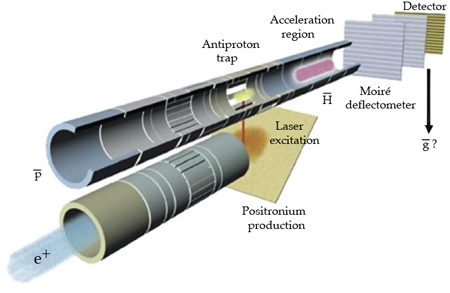Antihydrogen gravity
supported by the ERC Advanced Grant 291242-HBARHFS of E. Widmann
The AEgIS collaboration at CERN's Antiproton Decelerator aims at measuring the gravitational free fall of an anithydrogen beam. In order to reach the envisaged precision of 1 % in g the beam has to be at a temperature of about 100 mK. Since this is not possible by mixing an antiproton and positron plasma a more complex antihydrogen formation process is foreseen (Fig 8).
After trapping and cooling a bunch positrons is guided towards a nano-porous silica material. Inside the pores positronium is formed and leaves the material towards a cloud of cold antiprotons in a Penning trap. Via a charge exchange reaction the antiproton and the positronium form antihydrogen atoms. Using electrostatic fields these antiatoms are accelerated to form a beam at a velocity of about 400 m/s.
For gravity measurements the beam will pass through a Moiré defelctometer which consists of two gratings. By detecting the position of antihydrogen atoms after the gratings the gravitational acceleration can be infered.
Simulations show that the cold anithydrogen beam of AEgIS additionally offers an opportunity to perform hyperfine spectroscopy (HFS). For these measurements the module containing the gratings and the detector for gracity measurements will be replaced by the spectroscopy apparatus (Fig. 9). In contrast to ASACUSA's CUSP trap AEgIS will not produce a spin polarized antihydrogen beam. Therefore an additional sextupole magnet, acting as a polarizer, would have to be implemented in the beam line for HFS experiments.


